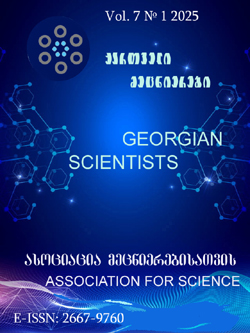Аннотация
The paper discusses the species diversity of harmful bark beetles spread in spruce forests at elevations ranging from 700 to 1500 meters above sea level in the municipalities of Shuakhevi and Khulo in the Autonomous Republic of Adjara during 2021–2023. These bark beetles damage the bark of oriental spruce (Picea orientalis L.), causing the trees to wither. The study also examines their natural enemies, including entomophagous and entomopathogenic microorganisms. Field studies were conducted in the Shuakhevi municipality at elevations between 700–900 meters and in the Khulo municipality at elevations between 1200–1500 meters. The research employed route-based expeditions, quadrat sampling, and insect trapping-identification methods. Statistical analysis of the collected data was performed using the mathematical modeling software IBM SPSS 23. The study identified three bark beetle species causing bark damage and tree mortality in the spruce forests of Shuakhevi and Khulo: Ips typographus Linnaeus, Ips sexdentatus Boerner and Dendroctonus micans Kugelann. It was established that all three species coexist under the bark. Their optimal distribution range was determined, and their bioecology, habitats on host plants, and natural enemies (entomophagous and entomopathogenic microorganisms) were studied. The identified natural enemies include:
- Rhizophagus dispar Paykull (Coleoptera, Monotomidae),
- Rhizophagus grandis Gyllenhal (Coleoptera, Monotomidae),
- Thanasimus formicarius Linnaeus (Coleoptera, Cleridae),
- Controtylenchus diplogaster (Nematoda, Diplogasteridae),
- Gregarina typographi (Apicomplexa, Gregarinidae),
- Chytridiopsis typographi (Microsporidia, Chytridiopsida),
- Beauveria bassiana (Sordariomycetes, Beauveria).
Библиографические ссылки
Manvelidze Z., Memiadze N., IN: The map-"100 European Forests We Should Protect Now", 1997, Georgia, 2022.
Burjanadze M., Supatashvili A., Harmful Bark beetles common in coniferous forests of Georgia, Georgia, 2020.
Zehnder G., Overview of Monitoring and Identification Techniques for Insect Pests, 2020. https://eorganic.org/node/2721
Dobrovolsky B. В. Phenology of insects: Ucheb. пособие для ун-тов, ped. и с.-х. узов. - M.: Vysshaya Shkola, 1969, p 232. (in Russia).
LSAM. How to Make an Insect Collection. lsuinsects. Org / DIY Insect Collection. pdf. DIY Insect Collection. http://lsuinsects.org
Busarova N.V., Negrobov O.P. Entomology. Key to insect families 2nd ed., Per. and additional Textbook for universities, 2020, p 182. (in Russia).
Jacobson G.G., Beetle determinant Eur. parts of the USSR. Leningrad, 1931, p 454. (in Russia).
Santín C., Doerr SH., Preston C., González‐Rodríguez G., Pyrogenic organic matter production from wildfires: a missing sink in the global carbon cycle. Global Change Biology, 1633, 2015.
Burjanadze M. Entomopathogenic fungi of Ips Typographus in Georgia. IOBC wprs Bulletin, Bulletin OILB srop, "Insect Pathogens and Insect Parasitic Nematodes", Vol. 30(1) pp 151-156, 2005
Abbott W.S., A method of computing the effectiveness of an insecticides, Journal of Economic Entomology 18, 1925, pp 265-267.
Marcus R., Eaves D.M., Statistical and Computational Analysis of Bioassay Data. In: Bioassays of Entomopathogenic Microbes and Nematodes. Navon, Amos, Ascher, K. R. S. (Editor), CAB Intl, p 324, 2000.

Это произведение доступно по лицензии Creative Commons «Attribution-NonCommercial-NoDerivatives» («Атрибуция — Некоммерческое использование — Без производных произведений») 4.0 Всемирная.
Copyright (c) 2025 Georgian Scientists





